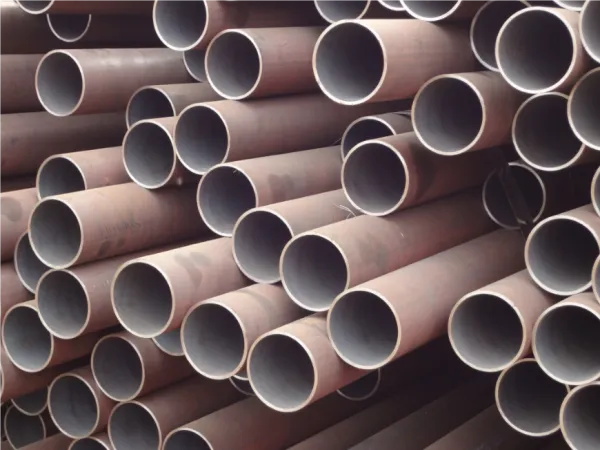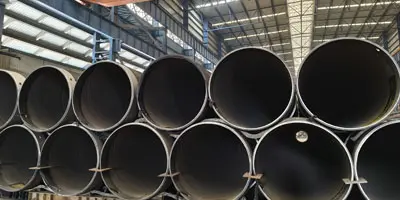Seamless carbon steel pipes are widely used in industries such as oil and gas, energy, and construction. Consistency in wall thickness is vital to ensure pipe strength, pressure resistance, and long-term reliability. However, uneven wall thickness remains a common issue during manufacturing. Understanding its causes helps improve product quality and reduce failure risks in practical applications.This article explores the leading causes of wall thickness variation in seamless carbon steel pipes and how manufacturers can address these issues effectively.

Understanding Seamless Pipe Manufacturing
Seamless carbon steel pipes are produced through hot working processes such as piercing,
rolling, and sizing. The process begins with a solid steel billet, which is heated and then pierced to form a hollow shell. This shell is then elongated and reduced in diameter and wall thickness using rolling mills.
Because no welding is involved, the wall thickness of seamless pipes should ideally be uniform. However, due to several factors in the production process, deviations can occur.
Main Causes of Uneven Wall Thickness
1.Uneven Heating of Billets Causes Wall Thickness Irregularities
The heating stage significantly affects the quality of seamless carbon steel pipes. When billets are not heated uniformly, one side becomes overheated while the other remains underheated. This temperature difference creates a condition called the “yin-yang billet.”In such cases, the overheated area becomes softer and more ductile. Meanwhile, the underheated area remains hard and resistant to deformation. During piercing, the two areas respond differently to the applied forces. This imbalance results in asymmetrical material flow, leading to variations in wall thickness.Proper rotation and movement of the billet inside the furnace help avoid these thermal imbalances. Consistent heating ensures uniform deformation in the subsequent rolling process.
2.Piercing Plug Damage Disrupts Metal Flow
The piercing process plays a crucial role in shaping seamless carbon steel pipes. At this stage, the billet is pierced to form a hollow shell or capillary. If the piercing plug (also called the top head) is worn or damaged, it can distort the flow of metal.A worn plug can develop bulges or raised areas on its surface. These irregularities affect how the metal flows around the plug during piercing. The result is a capillary with uneven internal geometry, which causes varying wall thickness in the final product.Regular inspection and maintenance of the piercing plug prevent such issues. A well-shaped and smooth plug promotes balanced metal distribution.
3.Improper Mandrel Position Affects Linear Thickness
In cold-drawn seamless carbon steel pipes, the mandrel must be aligned precisely. If the pre-piercing saddle does not position the mandrel correctly, it may touch the capillary on one side only. This contact causes that side of the pipe to cool faster than the opposite side.Rapid cooling makes the metal less ductile and harder to deform. As a result, that section resists further thinning during drawing, while the opposite side thins more. This imbalance causes linear wall thickness deviation along the length of the pipe.Precise control of mandrel height and alignment is essential for producing uniform wall thickness.
4.Entry Chain Vibration During Piercing Causes Instability
During the piercing stage, the billet must be fed smoothly into the rollers. However, if the steadying or guide rollers are not set correctly, the billet may not remain stable. This instability leads to vibration in the entry chain.As the billet vibrates, its feed becomes inconsistent. Uneven feeding leads to non-uniform piercing and causes spiral or wavy wall thickness variations along the pipe.Maintaining proper tension and support through the entry chain ensures smooth feeding and helps prevent wall thickness deviations.
5.Hole Expansion and Speed Variations Worsen Deformation
Seamless carbon steel pipes undergo controlled expansion during piercing. However, when the expansion index becomes too large, the pipe material deforms excessively. If the rolling speed is also too high, this deformation becomes unpredictable.High deformation under unstable rolling conditions causes inconsistent metal flow. These disturbances introduce irregularities in the pipe’s wall thickness, especially at the head and tail.Reducing the expansion ratio and optimizing rolling speeds can stabilize metal flow and improve wall thickness uniformity.
6.Misaligned Relief Hole at Pipe Head Increases Defects
When cutting the front end of the billet, incorrect relief hole positioning can create bending or slope. During the cold-drawing process, this misalignment leads to asymmetrical deformation. As a result, the pipe head develops thickness variations.Such problems are usually seen in large-diameter seamless carbon steel pipes. Ensuring that the relief hole is centered and straight improves symmetry and reduces wall inconsistencies.
7.Uneven Gap Between Rolling Mill Strips Affects Cold Drawing
Seamless carbon steel pipes undergo further processing in cold-drawing machines. The gap between the hot-rolled strips must match the setup parameters of the cold-drawing table. A mismatch between the actual and intended gaps can cause one side of the pipe to deform more than the other.This mismatch results in ultra-thin or ultra-thick sections, especially when using single or double rolling racks. Measuring and adjusting the rolling gap carefully helps maintain wall thickness uniformity during cold drawing.
8.Transition: Precision at Every Step Ensures Pipe Consistency
Wall thickness variations in seamless carbon steel pipes arise from issues at multiple stages. From billet heating to cold drawing, small deviations in setup can lead to major product inconsistencies. Implementing strict quality control and timely equipment maintenance helps prevent most of these defects.
Analysis of other reasons for uneven wall thickness of seamless steel pipes
1. The elongation coefficient of seamless steel pipes is too large when perforating, the rolling speed is too fast, and the rolling is stable.
2. The instability of the punch steel rough pipe can easily lead to uneven thickness at the tail.
3. The slope and bending of the end of the seamless steel pipe are too large, and the error of the center hole of the pipe is large, which can easily lead to uneven wall thickness of the top pipe.
4. Pay attention to the use of the state guide plate, increase the inspection of the guide plate bolts, reduce the deviation of the lead plate when rolling the seamless steel pipe, and ensure the stability of the cast steel.
5. Check the quality of the seamless steel pipe to prevent the slope and large diameter reduction of the pipe end. Correct the through hole alignment when replacing or repairing.
Consequences of Uneven Wall Thickness
Uneven wall thickness can have severe consequences on the performance and safety of seamless carbon steel pipes. This section explores the potential issues that may arise due to variations in wall thickness.
A. Structural Weakness
Reduced Load-Bearing Capacity: Areas with thinner walls are more susceptible to deformation and failure under stress. This can compromise the load-bearing capacity of the pipe, leading to structural failure.
Increased Vulnerability to Cracking: Uneven wall thickness can create stress concentrations, making the pipe more prone to cracking. This is particularly problematic in high-pressure applications where cracks can propagate rapidly.
B. Fluid Flow Impairment
Flow Restrictions: Variations in wall thickness can disrupt the smooth flow of fluids within the pipe. This can lead to increased resistance, pressure drops, and reduced overall efficiency.
Turbulence and Erosion: Abrupt changes in wall thickness can induce turbulence in the fluid flow, promoting erosion and increasing the likelihood of corrosion in certain areas.
C. Corrosion Susceptibility
Localized Corrosion: Thinner areas are more susceptible to localized corrosion, especially in corrosive environments. This can lead to premature failure and a decrease in the overall lifespan of the pipe.
Galvanic Effects: Variations in wall thickness can create galvanic effects, where different sections of the pipe corrode at different rates. This can accelerate corrosion in specific areas, further compromising the pipe's integrity.
Detection Methods for Wall Thickness Deviation
Early detection of wall thickness deviation is vital to maintain quality. The following methods are commonly used:
Ultrasonic Testing (UT): Non-destructive, accurate wall thickness measurement.
Eddy Current Testing: Detects surface and near-surface flaws.
Laser Gauges: Measures pipe dimensions in real time during production.
Manual Micrometer Inspection: For final checks in quality control.
Conclusion
Uneven wall thickness in seamless carbon steel pipes poses a significant challenge to the reliability, safety, and efficiency of these critical components in various industries. Understanding the causes, consequences, and methods for detection and correction is essential for manufacturers, engineers, and industry stakeholders. With advancements in inspection technologies, materials science, and manufacturing processes, the future holds promising solutions to minimize the occurrence of uneven wall thickness and ensure the continued integrity of seamless carbon steel pipes. By embracing these advancements and adhering to best practices, the industry can enhance the performance and longevity of seamless carbon steel pipes, contributing to the overall success of the sectors they serve.
FAQ
Q1: Why is wall thickness uniformity important in seamless pipes?
Uniform thickness ensures mechanical strength, pressure resistance, and safety in
pipelines and structural applications.
Q2: Can uneven wall thickness be corrected after production?
Generally, no. Seamless pipes are hard to modify post-production without compromising integrity.
Q3: What industries are most affected by pipe wall thickness variation?
Oil and gas, nuclear power, aerospace, and chemical industries where precision and safety are critical.
Q4: How does wall thickness affect pipe pressure rating?
Thicker walls can handle higher pressures, but uneven walls may cause weak points, reducing safe pressure limits.






 English
English Español
Español بالعربية
بالعربية











 Phone :
Phone :  Whatsapp :
Whatsapp :  Email :
Email : 


